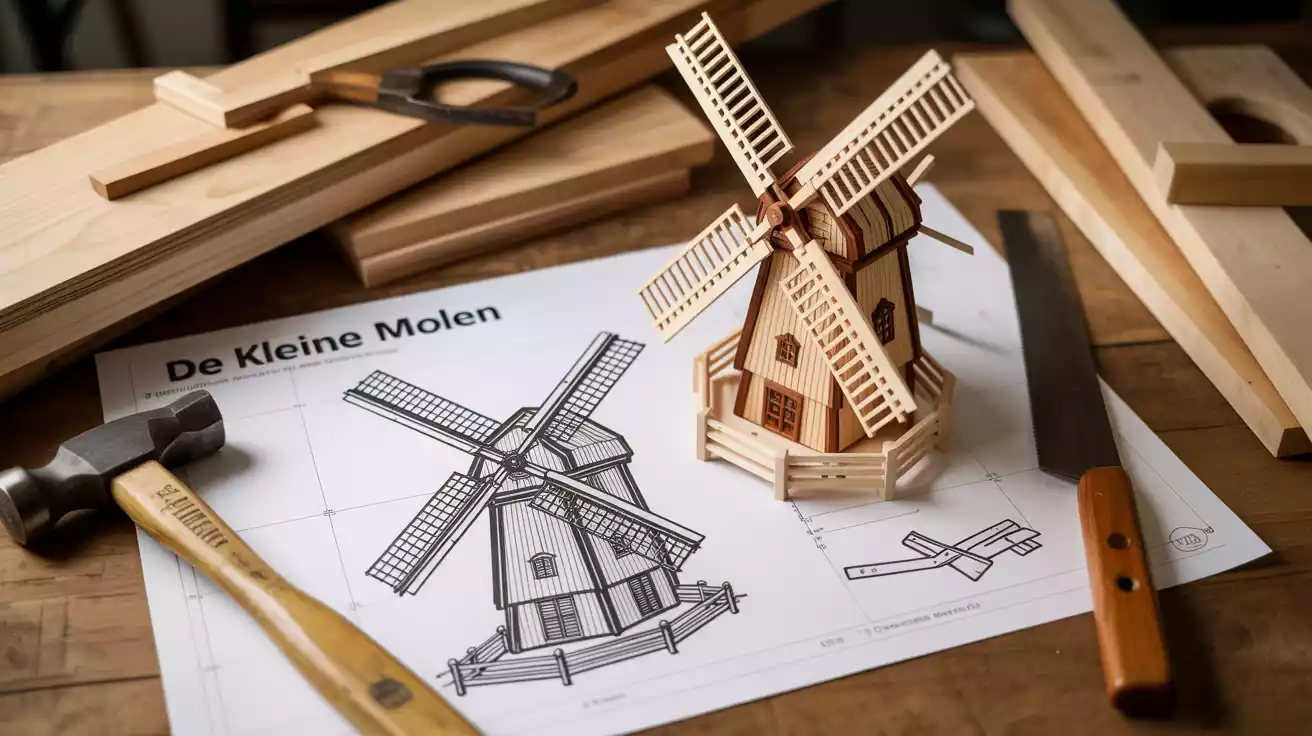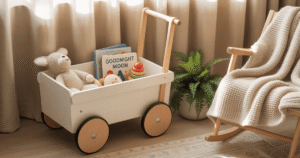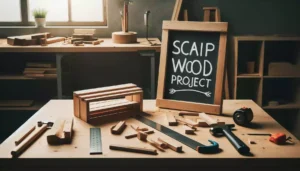
You’ve probably seen them in gardens and backyards. Their wooden slats move softly in the wind. DIY wooden windmills are now a favorite outdoor decoration, bringing rustic charm to any spot.
There are many designs and plans online to make your own windmill. You can choose from simple projects to more complex DIY endeavors. The options are vast.
Exploring DIY wooden windmills opens up a world of inspiration and help. It guides you in bringing your dream project to life.
Key Takeaways
- Get inspired by unique DIY wooden windmill designs from around the world.
- Learn various construction techniques for creating your own windmill.
- Discover the benefits of using wooden materials for your windmill.
- Explore different designs and plans available online.
- Create a beautiful and functional windmill for your outdoor space.
The Timeless Appeal of Wooden Windmills
Wooden windmills have always been fascinating. They bring a rustic charm and carry a deep history. For ages, these structures have been more than just parts of the landscape. They’ve become symbols of many cultures.
Historical Significance and Evolution of Windmills
Windmills started in ancient Persia, now Iran, in the 9th century. They spread to the Middle East and Europe, changing over time. The Netherlands is famous for its windmills, used for tasks like milling grain and pumping water.
Windmills show human creativity and the need for green energy. As technology grew, so did windmill designs, leading to today’s variety.

Benefits of Adding a Wooden Windmill to Your Outdoor Space
Wooden windmills can make your outdoor area look better. They add a historical charm or serve as a decorative piece. They fit many garden styles.
Building a wooden windmill yourself is a fun project. With wooden windmill plans available, you can pick a design that matches your skills and decor.
Understanding Scale and Placement Options
Choosing the right size and spot for your windmill is key. The windmill should fit well in its area. This ensures it looks good and doesn’t overwhelm the space.
| Windmill Size | Ideal Placement | Aesthetic Impact |
|---|---|---|
| Small (Under 3 feet) | Tabletop or small gardens | Delicate, subtle charm |
| Medium (3-6 feet) | Yards and medium-sized gardens | Statement piece, adds character |
| Large (Over 6 feet) | Acreage and farms | Dominant feature, significant visual impact |
Choosing the right size and spot makes your windmill stand out. It turns your outdoor space into a welcoming, stylish area that shows off your taste.
Essential Tools and Materials for Your DIY Wooden Windmill Project

Starting a wooden windmill project means knowing what tools and materials you need. It’s important to plan well to make sure your project is strong and looks good.
Must-Have Woodworking Tools for Beginners and Experts
For a handmade wooden windmill, the right tools are key. You’ll need a table saw, drill press, sandpaper, and clamps. These help you cut, shape, and put your windmill together right.
Selecting the Right Wood Types for Durability and Aesthetics
The wood you pick affects your windmill’s strength and look. Cedar and redwood are good because they resist rot and bugs. Think about the wood’s color and grain to get the look you want.
Additional Materials, Hardware, and Weatherproofing Supplies
You’ll also need metal rods for the axis, bearings for smooth turning, and weatherproofing stuff like sealants and paints. These help your windmill last through different weather.
| Material | Usage | Benefits |
|---|---|---|
| Cedar | Main structure | Resistant to rot and insects |
| Metal rods | Axis and support | Provides stability and durability |
| Weatherproof sealants | Protecting wood | Extends lifespan by protecting against moisture |
Choosing the right tools and materials will help you make a beautiful and useful DIY wooden windmill. It will make your outdoor space even better.
Dutch-Inspired Wooden Windmill Designs

The Netherlands is known for its windmills. You can add a piece of this heritage to your outdoor space with a Dutch-inspired wooden windmill design. Dutch windmills are famous for their innovative use in many industries. Their designs have been perfected over centuries.
Traditional Dutch Windmill Features and Proportions
Traditional Dutch windmills have a distinctive cap and large, rotating blades. To create a true Dutch-inspired design, pay attention to the proportions. The height of the windmill is usually 1.5 to 2 times the length of the blades. Getting the proportions right is essential to capture the Dutch windmill design’s essence.
Windmill historians say, “The proportions of a windmill are key to its beauty. A well-designed windmill can be a highlight in any garden or landscape.”
“The beauty of a windmill lies not just in its functionality, but in its ability to blend into the surrounding landscape while making a statement.”
Simplified Dutch Designs for Weekend Projects
If you want to make a Dutch-inspired windmill over a weekend, simplify the design. Use pre-cut wooden components or focus on the cap and blades. Even with a simplified design, you can still capture the true Dutch windmill style.
- Use pre-cut wooden kits to simplify the construction process.
- Focus on the cap and blade design to capture the essence of Dutch windmills.
- Consider using reclaimed wood to add character to your project.
Creating Authentic Rotating Blade Mechanisms
A key feature of Dutch windmills is their rotating blades. To create a real rotating mechanism, design a system that lets the blades turn freely. This can be done with a simple bearing or pivot system. The rotating blades add visual interest and honor the functional heritage of Dutch windmills.
By adding these elements, you can make a Dutch-inspired wooden windmill. It will be a tribute to the Netherlands’ rich windmill heritage and a unique garden feature.
American Farmhouse Windmill Styles

American farmhouse windmill styles are a big hit in rustic decor. They bring charm and character to your outdoor area. These designs honor the U.S.’s agricultural past and add a nostalgic feel to modern gardens.
Classic American Farm Windmill Characteristics
Classic American farm windmills are simple and practical. They have a tall, narrow tower with a spinning wheel on top. The rustic aesthetic comes from using natural materials like wood and metal.
- Simple, functional design
- Tall, narrow tower structure
- Rotating wheel at the top
- Use of natural materials like wood and metal
Rustic Prairie Windmill Designs with Metal Accents
Rustic prairie windmill designs often use metal for durability and style. You can mix wooden slats with metal parts, like a metal wheel or trim.
For rustic windmill decor inspiration, add metal accents with a distressed finish. This gives your windmill a weathered look.
Miniature Farmhouse Windmill Projects for Limited Spaces
Even with limited space, you can enjoy the charm of American farmhouse windmills. Miniature versions are great for do it yourself windmill ideas. They fit well on a tabletop or in a small garden.
By following these design tips, you can make your own unique American farmhouse windmill. It will add character and charm to your outdoor space.
Stunning DIY Wooden Windmill Designs Inspiration from Asia

Asia’s rich culture inspires stunning wooden windmills for your outdoor space. You can mix various design elements and techniques from Asia into your project.
Windmills have long been part of Asian architecture and gardens. Japan uses Dutch windmill designs in parks and gardens. China is known for its detailed decorative windmills.
Japanese Windmill Design Elements and Techniques
Japanese windmills mix traditional and modern styles. They use minimalist wooden blades and intricate joinery. They also focus on blending with nature, using natural finishes.
Chinese Decorative Windmill Concepts with Intricate Details
Chinese windmills are famous for their detailed carvings. You can add dragons and phoenixes to your windmill for cultural flair. Mixing wood and metal creates a striking look.
Korean and Southeast Asian Adaptations for Modern Gardens
Korean and Southeast Asian designs are great for modern gardens. You can add Hanok-inspired features like tiled roofs. Thai and Vietnamese designs offer colorful and intricate ideas.
Exploring Asian design elements gives a new twist to wooden windmills. You can make a unique DIY windmill that shows your style and adds cultural flair to your garden.
“The best way to get started is to quit talking and begin doing.”
Walt Disney
European Countryside Windmill Creations

From the Mediterranean to Scandinavia, European windmills show a variety of styles. You can use these as inspiration for your own DIY wooden windmill.
Mediterranean Windmill Styles with Terracotta Accents
Mediterranean windmills are famous for their terracotta and rustic charm. You can add terracotta pots or tiles to your wooden windmill. This will bring warmth and authenticity.
Use weather-resistant woods like cedar or cypress. Add terracotta or clay tiles for roofing. This mix of materials will make your windmill cozy and inviting.
Scandinavian Minimalist Designs for Contemporary Spaces
Scandinavian windmills are known for their simple look and clean lines. You can make a modern windmill with light woods and simple shapes.
Add metal accents or use a simple color scheme for a Scandinavian look. This style is great for modern outdoor spaces.
Eastern European Decorative Patterns and Color Schemes
Eastern European windmills have detailed patterns and bright colors. Use brightly colored paints or carved wood for your windmill. This will add interest and a cultural twist.
Look into traditional Eastern European designs for your windmill. This will make your windmill stand out and add cultural depth.
| Windmill Style | Characteristic Features | Materials |
|---|---|---|
| Mediterranean | Terracotta accents, rustic charm | Cedar, cypress, terracotta tiles |
| Scandinavian | Minimalist design, clean lines | Light-colored woods, metal accents |
| Eastern European | Intricate patterns, vibrant colors | Brightly colored paints, carved wood |
Size Variations and Installation Techniques

The size of your wooden windmill project is key to its look and use. It’s important to pick the right size for your space. Whether it’s a small desk model or a big installation, knowing the sizes and how to install them is crucial.
Tabletop and Small Garden Windmills Under 3 Feet
Small wooden windmills are great for decoration or as gifts. They fit well on desks, shelves, or small gardens. When making these tiny models, focus on details and precision. You can use pre-cut wooden kits or make your own pieces from scratch.
Medium-Sized Statement Pieces for Yards and Gardens
Medium-sized windmills make a statement in yards or gardens, adding rustic charm. They’re usually 3 to 6 feet tall. Adding copper accents or colorful blades makes them stand out.

Large-Scale Windmill Projects for Acreage and Farms
For bigger spaces like farms or acreage, large wooden windmills are both useful and decorative. They need more materials and work but are very rewarding. Use durable woods like cedar or redwood for lasting quality.
Proper Foundation and Mounting Methods for Stability
Proper installation is vital for any windmill’s stability and life span. Smaller models need a strong base or bracket. But, bigger ones might need a concrete base to stay upright in windy weather.
| Windmill Size | Ideal Location | Installation Requirement |
|---|---|---|
| Under 3 Feet | Tabletop, Small Garden | Sturdy base or mounting bracket |
| 3-6 Feet | Yard, Garden | Partial foundation or deep anchoring |
| Over 6 Feet | Acreage, Farms | Concrete foundation |
Knowing about size and installation for your DIY wooden windmill project helps create a beautiful piece. It can be a stunning addition to your outdoor space. Whether you’re experienced or new, the right plan and effort can lead to success.
Functional vs. Decorative Wooden Windmills

Wooden windmills are versatile, offering both functional and decorative options. They can enhance your garden’s look or its usefulness. Knowing the difference between these types is key.
Working Windmills for Garden Irrigation and Water Features
Functional wooden windmills can pump water for irrigation and water features. They create a peaceful, self-sustaining garden ecosystem. For example, a custom windmill construction can meet your garden’s needs, blending function and beauty.
When designing a functional windmill, think about its size and where to place it. It should work well without taking over the garden.
Small-Scale Electricity-Generating DIY Designs
Small-scale windmills can generate electricity, a great DIY project. With handmade wooden windmill tutorials, you can make one that powers your garden and looks unique.
Creating these windmills needs careful planning. You’ll need to pick the right materials and add electrical parts.
Purely Decorative Windmill Projects with Seasonal Adaptations
Decorative wooden windmills add charm to your garden. They can change with the seasons, using different themes and colors.
Lighting Integration Options
Decorative windmills look even better with lights. Solar-powered or fairy lights can make your garden glow in the evening.
Weathervane Functionality Add-Ons
A weathervane on your windmill adds both function and style. It shows wind direction and adds rustic charm.
In conclusion, wooden windmills come in functional and decorative styles. Choose based on your needs and add features like lights or weathervanes. This way, you can make your outdoor space unique and beautiful.
🔨 Ready to Take Your Woodworking to the Next Level?

If building a wooden windmill excites you, imagine what you could create with 16,000+ step-by-step woodworking plans at your fingertips! Whether you’re a beginner or a pro, Ted’s Woodworking will transform your ideas into reality—easily and affordably.
✅ Instant Access to 16,000 “Done-for-You” Projects
✅ No Guesswork—Clear Schematics, Materials Lists & Instructions
✅ Perfect for Beginners—No Fancy Tools or Workshop Needed
✅ New Plans Added Every Month – Yours for Life!
✅ Save Time, Money & Materials on Every Project
🎁 BONUS: Get free monthly project plans + request custom designs!
👉 Don’t just build a windmill. Build your dream woodworking lifestyle.
💡 Click Here to Get Instant Access to Ted’s Woodworking Now!
Make your next project smarter—not harder.
Conclusion: Bringing Windmill Magic to Your Outdoor Space
You now have the inspiration and guidance to create stunning DIY wooden windmill designs for your outdoor space. With various styles and sizes to choose from, you can select the perfect DIY wooden windmill to enhance your garden or yard.
From Dutch-inspired designs to American farmhouse styles, and from Asian to European countryside creations, the options are endless. You can choose a functional or decorative windmill, depending on your needs.
With the right tools and materials, you can bring your chosen design to life. Explore stunning DIY wooden windmill designs inspiration, and get creative with your project. A well-crafted DIY wooden windmill can add a touch of magic to your outdoor space.
FAQ
What type of wood is best for a DIY wooden windmill project?
For a DIY wooden windmill, choose wood that’s both durable and looks good. Cedar, cypress, and redwood are top picks. They resist rot and insects well.
How do I ensure the stability of my wooden windmill?
For stability, start with a solid foundation and mounting. Big windmills need deep foundations or anchors to avoid damage from wind.
Can I build a functional windmill for generating electricity?
Yes, you can make a small windmill that generates electricity. But, it needs careful planning, precise engineering, and local rules.
What are the key elements of a traditional Dutch windmill design?
Dutch windmills have a unique cap, spinning blades, and a strong body. To get this look, focus on the right size, materials, and details.
How do I choose the right size for my wooden windmill?
Pick a size based on your space, what you want to achieve, and its purpose. Small ones fit on tables, while big ones are for farms.
Can I customize my wooden windmill with unique features?
Yes, you can add special features like lights, a weathervane, or seasonal changes. This makes your windmill more interesting and useful.
What are the benefits of adding a wooden windmill to my outdoor space?
A wooden windmill adds beauty, calm, and a talking point to your outdoor area. It makes your space more inviting.
How do I weatherproof my wooden windmill?
To protect your windmill, use strong finishes, sealants, and coatings. Regular checks and part replacements are key to keeping it in good shape.



